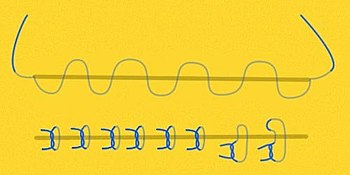Intracutaneous suture

lower row: 6 single button sutures followed by an Allgöwer and a Donati suture . As a result, a lot of punctures in the skin.
The intracutaneous (from Latin. "Cutis" skin ) or intracutaneous skin suture is a special form of skin suture in medicine , the thread back slightly in beneath the skin surface and herwendelt.
The purpose of the intracutaneous suture is to avoid puncture channels that remain visible as white, punctiform scars as far as possible: the skin surface is only injured at the beginning and end of the suture. Intracutaneous sutures are suitable for straight and tension-free wounds, as they usually occur during operations. Usually, the fatty tissue under the skin is sutured with self-dissolving sutures beforehand , so that the intracutaneous suture hardly absorbs any more forces, but only has to hold the top layer of skin together.
In abdominal operations, wound dehiscences were less common than with staples .
Intracutaneous sutures are also occasionally used in veterinary medicine . Many animals instinctively try to pull out the protruding threads, which they perceive as foreign bodies in their wound, and can inadvertently tear open their still fresh surgical wounds. Intracutaneous sutures stick out little or nothing, so the animal is unable to tear out the threads (necessary for healing).
Individual evidence
- ↑ Elisabeth Maurer, Detlef K. Bartsch a. a .: Superficial wound infections after intracutaneous skin sutures versus staples. In: Deutsches Ärzteblatt. Volume 116, Issue 21, 2019, pp. 365–371.